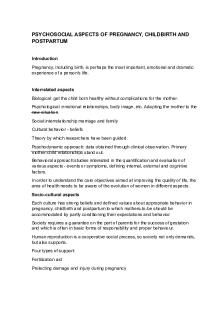Nine Aspects of Beliefs Summary PDF

| Title | Nine Aspects of Beliefs Summary |
|---|---|
| Course | Learning For Catholic Religious Education |
| Institution | La Trobe University |
| Pages | 2 |
| File Size | 48.5 KB |
| File Type | |
| Total Downloads | 20 |
| Total Views | 171 |
Summary
Tutor Notes for a Year 12 VCE student....
Description
Nine Aspects of Beliefs Summary Beliefs – expressed through stories that are found in texts, expressed through rituals that might use symbols or artifacts, provide the foundation for ethical principles, give meaning to spiritual experiences as they provide a lens from which the experience is viewed, the social structure of a religion often finds it’s origins in foundational beliefs and ‘directions’ from the UR or founder of the tradition. Particular beliefs can be linked to space, place and time given that they have a historical component. Sacred Stories – found in texts and may make reference to the other aspects. Can be a way of explaining ethical principles. Often relate directly to space, place and time given they provide a context for a religious truth. The retelling of stories can involve symbols and may be done through visual representation in a place or as part of a ritual. Sacred stories can provide a teaching function and are employed in the social structure as a way of passing on beliefs and tradition. Rituals – express in a tangible way the beliefs of a tradition. Can involve artifacts, texts and symbols and are often performed in specific space, place and at a particular time. Some rituals are described in texts and the intention of them is to connect with UR. In some traditions, following rituals is part of the ethical framework and is an expectation to be upheld. The enactment of the ritual itself draws adherents into a spiritual experience. Texts – are considered by many traditions to hold particular authority and are therefore the source of ethical frameworks. They articulate beliefs and often describe rituals and social structures. They can in themselves be artifacts and can also refer to spaces, places, times and artifacts as they hold the history of the tradition. The consultation of the text can lead an individual or a community to engagement with the divine thus providing a spiritual experience. Symbols – are a representation of a belief or significance attributed to an object or item that links it to beliefs. Symbols can be talked about in Stories and Texts and may be visually or physically represented in space and place. Particular symbols are often aligned with specific times in a religious tradition and can take on a role of teaching and passing on the tradition, thus contributing to the social structures. The assist in facilitating spiritual experiences by making the sacred more tangible, the invisible visible. Ethics – are most often related to Texts as traditions tend to record the codification of their beliefs which then inform their ethical approach. Texts are considered by most traditions to hold authority and so this authority passes to the ethical assertions. Social Structures of the tradition enable ethics to be discussed, understood and upheld while rituals can incorporate and ethical view eg. marriage. Space, Place, Time and Artifacts – these aspects are often integrated as they are the way in which religious traditions set out space and time to devote to the sacred. They often have a historical function, holding the traditions of the religious community that are set out in the texts. They are often closely linked with ritual as rituals are made more meaningful by being given visibility through space and time. Texts also often outline space, place and time as well as artifacts given that religious texts hold and express the history of the religious people.
Social Structure – religious traditions have organisation which allows individuals and the community to access the tradition and experience the tradition in a meaningful way. The structures facilitate discussion and clarification about beliefs and ethical frameworks as well as reaffirmation and reformulation of practices that express the beliefs such as rituals and symbols. Leaders in every tradition are often called upon to translate or consult religious texts and look for the meaning in stories. Spiritual experience – an individual can be involved in a spiritual experience through their interaction with one or many of the other aspects. A spiritual experience can be facilitated through involvement in a ritual that happens at a particular place, in a particular space and at a dedicated time. Artifacts too can provide a focus for prayer and worship that may take the adherent to a place of powerful emotion. Symbols and text can transform and ordinary experience into a spiritual experience by connecting the adherent to a deeper meaning and a connection with what they consider to be divine....
Similar Free PDFs

Nine Aspects of Beliefs Summary
- 2 Pages

AP Gov The Nine Summary
- 2 Pages

Legal Aspects of Nursing
- 5 Pages

Behavioural Aspects of Budgeting
- 7 Pages

Psychosocial Aspects OF Pregnancy
- 19 Pages

MCQ - Legal Aspects of Business
- 25 Pages

Aspects of language meg-4
- 7 Pages

Belbin’s aspects of team working
- 4 Pages

Legal Aspects of Business MCQs
- 26 Pages

TOPIC 1. Aspects of Marketing
- 14 Pages
Popular Institutions
- Tinajero National High School - Annex
- Politeknik Caltex Riau
- Yokohama City University
- SGT University
- University of Al-Qadisiyah
- Divine Word College of Vigan
- Techniek College Rotterdam
- Universidade de Santiago
- Universiti Teknologi MARA Cawangan Johor Kampus Pasir Gudang
- Poltekkes Kemenkes Yogyakarta
- Baguio City National High School
- Colegio san marcos
- preparatoria uno
- Centro de Bachillerato Tecnológico Industrial y de Servicios No. 107
- Dalian Maritime University
- Quang Trung Secondary School
- Colegio Tecnológico en Informática
- Corporación Regional de Educación Superior
- Grupo CEDVA
- Dar Al Uloom University
- Centro de Estudios Preuniversitarios de la Universidad Nacional de Ingeniería
- 上智大学
- Aakash International School, Nuna Majara
- San Felipe Neri Catholic School
- Kang Chiao International School - New Taipei City
- Misamis Occidental National High School
- Institución Educativa Escuela Normal Juan Ladrilleros
- Kolehiyo ng Pantukan
- Batanes State College
- Instituto Continental
- Sekolah Menengah Kejuruan Kesehatan Kaltara (Tarakan)
- Colegio de La Inmaculada Concepcion - Cebu





